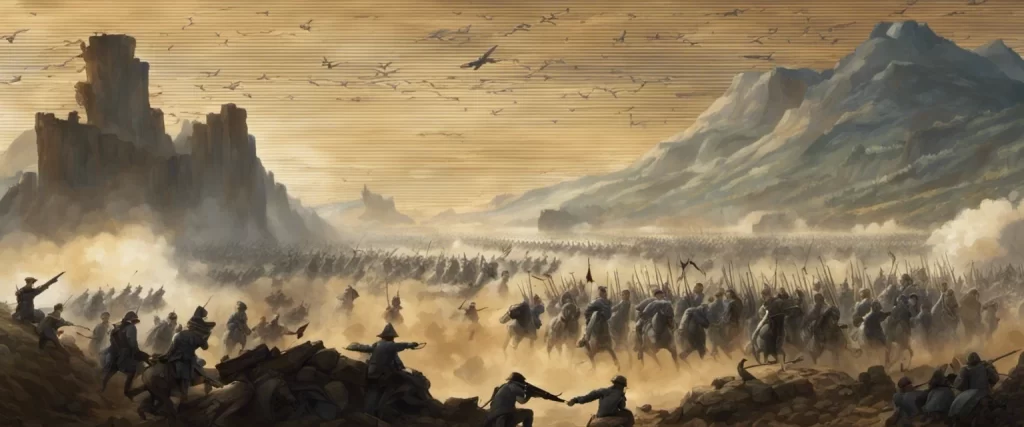—The Art of War & The 33 Strategies of War
Warfare has been an essential component of human history, shaping the course of nations and shaping the destiny of civilizations. Over time, countless scholars, military strategists, and philosophers have sought to unravel the mysteries of war, to dissect its intricacies, and to provide guidance for those who venture into this treacherous terrain. Among the myriad of texts dedicated to this subject, two works stand out: “The Art of War” by Sun Tzu and “The 33 Strategies of War” by Robert Greene.
Considered to be seminal works in the realm of military strategy, these two books explore the art of war from different perspectives, separated by centuries of cultural, historical, and technological advancements. Sun Tzu’s treatise, originating from ancient China, has fascinated readers for millennia with its timeless wisdom. Meanwhile, Robert Greene’s contemporary analysis examines military strategy through the lens of historical events and the experiences of great leaders.
In this comparative study, we embark on an intellectual journey to analyze and compare the strategies presented in these two seminal works. By understanding the similarities and differences between Sun Tzu’s “The Art of War” and Robert Greene’s “The 33 Strategies of War,” we aim to shed light on the enduring lessons that can be derived from these texts and their relevance in contemporary contexts.
The Art of War, written by Sun Tzu around the 5th century BC, remains a celebrated masterpiece. With its concise yet profound teachings, the book addresses the principles of war as well as the psychology behind strategizing and achieving victory. Sun Tzu articulates the significance of knowing oneself, understanding the enemy, and manipulating circumstances to gain advantage on the battlefield. The text has endured for centuries due to its timeless wisdom and ability to transcend temporal and cultural barriers, making it relevant even in the modern world.
On the other hand, Robert Greene’s “The 33 Strategies of War,” published in 2006, takes a broader approach. Drawing heavily from historical events and showcasing the practices of well-known military figures, Greene provides readers with an engaging narrative that intertwines strategy, psychology, and power dynamics. By examining both successful and failed military campaigns, Greene highlights the principles and tactics that can be applied to various situations on an individual and collective level. His work include The 48 Laws of Power.
Although separated by vast temporal and cultural gaps, both texts share a central purpose: to unlock the secrets of warfare and guide readers towards strategic success. Through this comparative study, we aim to delve into the depths of these works, tracing their philosophical origins, exploring their key principles, and evaluating their practical applications in contemporary scenarios.
In analyzing Sun Tzu’s “The Art of War” and Robert Greene’s “The 33 Strategies of War,” we will scrutinize their similarities and differences, evaluating the impact of time, culture, and evolving paradigms on strategic thinking and application. By doing so, we hope to gain a comprehensive understanding of the enduring principles of war and the evolving nature of strategic thought, bridging the gap between ancient wisdom and modern sensibilities.
Brief Summary of Two Books
The Art of War by Sun Tzu
“The Art of War” by Sun Tzu is a classic military strategy book written over 2,500 years ago in ancient China. It is composed of thirteen chapters, each focusing on various aspects of warfare. The book delves into strategic planning, tactics, and the psychological elements of conflict, emphasizing the importance of patience, deception, and understanding the enemy’s strengths and weaknesses. Sun Tzu’s teachings revolve around the concept of winning battles without necessarily engaging in physical combat, promoting the idea that the most successful wars are those won through careful planning and knowledge rather than brute force. The lessons presented in “The Art of War” are still relevant today and can be applied to various fields beyond warfare, such as business, politics, and everyday life.
The 33 Strategies of War by Robert Greene
The 33 Strategies of War” by Robert Greene is a guidebook that delves into timeless principles and strategies used by military commanders and strategists throughout history. Drawing lessons from various historical figures and events, including the likes of Sun Tzu, Napoleon Bonaparte, and Winston Churchill, the book provides readers with a comprehensive understanding of how to navigate and succeed in the complex game of war. Each strategy is accompanied by detailed explanations, examples, and practical tips, making it a valuable resource for anyone seeking to enhance their decision-making abilities, strategic thinking, and negotiation skills in both personal and professional aspects of life.
Comparison between Two Books

Similarities in warfare
Both “The Art of War” by Sun Tzu and “The 33 Strategies of War” by Robert Greene offer valuable insights and strategies when it comes to the subject of warfare. Despite being written centuries apart, these books share several similarities in their approach to understanding and executing successful military campaigns. Here are some common themes and similarities between them:
1. Importance of Strategy: Both books emphasize the significance of strategy as a fundamental element of warfare. They argue that a well-considered plan is crucial for achieving victory and minimizing losses.
2. Understanding the Enemy: Sun Tzu and Greene highlight the importance of thoroughly understanding the enemy and their strategies. They suggest that by studying the opponent’s strengths, weaknesses, and motivations, one can exploit their vulnerabilities and gain an advantage on the battlefield.
3. Deception and Psychological Warfare: Both books advocate for the use of deception and psychological warfare. They explore methods of manipulating the enemy’s perceptions, creating confusion, and exploiting their fears and weaknesses, all with the goal of gaining the upper hand.
4. Adapting to Changing Circumstances: Sun Tzu and Greene stress the need for adaptability in war. They argue that the ability to adjust one’s strategies and tactics to fit the evolving circumstances of the battlefield is crucial for success.
5. Avoiding Direct Conflict: Both books suggest that avoiding direct conflict whenever possible is often a wise strategy. They promote the idea of winning through subtler means, such as outmaneuvering the enemy or using diplomacy to secure alliances.
6. The Importance of Intelligence: Sun Tzu and Greene emphasize the significance of accurate and timely intelligence in warfare. They emphasize the need for gathering information about the enemy’s plans, capabilities, and intentions to make informed decisions and gain a strategic advantage.
7. Understanding One’s Own Strengths and Weaknesses: Both books stress the significance of self-assessment. They encourage individuals or armies to recognize their strengths and weaknesses honestly, which is essential for setting realistic goals and devising effective strategies.
8. Preparation and Logistics: Sun Tzu and Greene acknowledge the importance of meticulous preparation and logistics in warfare. They emphasize the need for proper training, supply chains, and overall organization to ensure that the execution of strategies goes smoothly.
Despite the notable differences in their writing style and historical contexts, “The Art of War” and “The 33 Strategies of War” share many core principles when it comes to successful warfare. By studying and applying these principles, a reader gains a deeper understanding of the complexities of conflict, both on the battlefield and in other areas of life.
Divergences in warfare
The Art of War by Sun Tzu and The 33 Strategies of War by Robert Greene are two classic books that explore the principles and strategies of warfare. While both books focus on the art of winning battles and achieving victory, there are some significant divergences in the approach and themes presented in each.
1. Historical Context: The Art of War is an ancient Chinese text dating back more than 2,500 years, whereas The 33 Strategies of War is a more modern book that draws inspiration from diverse historical periods, including ancient China, Greece, Renaissance Europe, and more recent conflicts. This difference in historical context results in variations in the examples and references used by the authors.
2. Structure and Format: The Art of War is a concise and straight-to-the-point book, divided into thirteen chapters, each dedicated to different aspects of warfare. Sun Tzu’s writing is highly concise, with metaphors and poetic language often employed to convey his ideas. In contrast, The 33 Strategies of War is a more expansive work, divided into chapters dedicated to specific strategies. Robert Greene uses a narrative style, weaving historical anecdotes and case studies into each strategy to make them more relatable and understandable for the reader.
3. Emphasis on Psychology: Both books recognize the importance of psychological elements in warfare, but they differ in terms of emphasis. Sun Tzu places greater importance on understanding one’s own psychological state and the psychology of the enemy. He emphasizes the concept of deception, using surprise and manipulation to gain an advantage. On the other hand, Robert Greene explores a broader range of psychological tactics and strategies, including manipulation, misdirection, and fear.
4. Distinction between Strategy and Tactics: Sun Tzu’s The Art of War primarily focuses on strategic planning, long-term vision, and assessing the overall situation. He pays less attention to specific tactical actions or maneuvers. In contrast, Robert Greene’s The 33 Strategies of War delves into both strategic and tactical components, with a greater emphasis on specific actions to be taken in different situations.
5. Leadership and Governance: While Sun Tzu addresses leadership and governance, his emphasis is on personal virtue, discipline, and the importance of the ruler’s loyalty to his subjects. He believes that a well-governed state leads to victorious warfare. In contrast, The 33 Strategies of War offers a broader perspective on leadership, encompassing political cunning, adaptability, and maintaining control.
Overall, The Art of War and The 33 Strategies of War present different approaches to warfare, reflecting the distinct historical periods they were written in and the authors’ perspectives. While Sun Tzu emphasizes strategy, psychology, and leadership within a specific cultural and historical context, Robert Greene’s book offers a more modern, comprehensive examination of various strategies, incorporating examples and lessons from throughout history.

Conclusion
Both The Art of War by Sun Tzu and The 33 Strategies of War by Robert Greene are highly regarded books on the subject of warfare and strategy. They both offer unique perspectives and valuable insights that can be applied in various aspects of life beyond just warfare.
The Art of War, written over 2,000 years ago, is considered a classic in military strategy. It emphasizes the importance of understanding oneself, the enemy, and the terrain to achieve success in any conflict. Sun Tzu’s principles are concise, profound, and often metaphorical, making it a timeless text that continues to be studied and admired by readers around the world.
On the other hand, The 33 Strategies of War by Robert Greene is a more modern book that draws from historical examples and a wide range of sources to present strategies for success in various competitive and conflict-driven situations. It expands on the principles of warfare and applies them to politics, business, and everyday life. Greene’s book is more extensive and provides a broader range of strategies compared to Sun Tzu’s work.
Ultimately, whether one book is more worthy of reading than the other depends on individual preferences and goals. If you are interested in a concise, philosophical approach to warfare strategy, The Art of War is a must-read. If you prefer a more extensive and practical guide with diverse applications, The 33 Strategies of War may be a better fit. Both books offer valuable insights into strategy, and reading both would provide a more comprehensive understanding of the subject.



